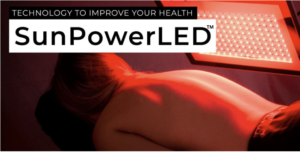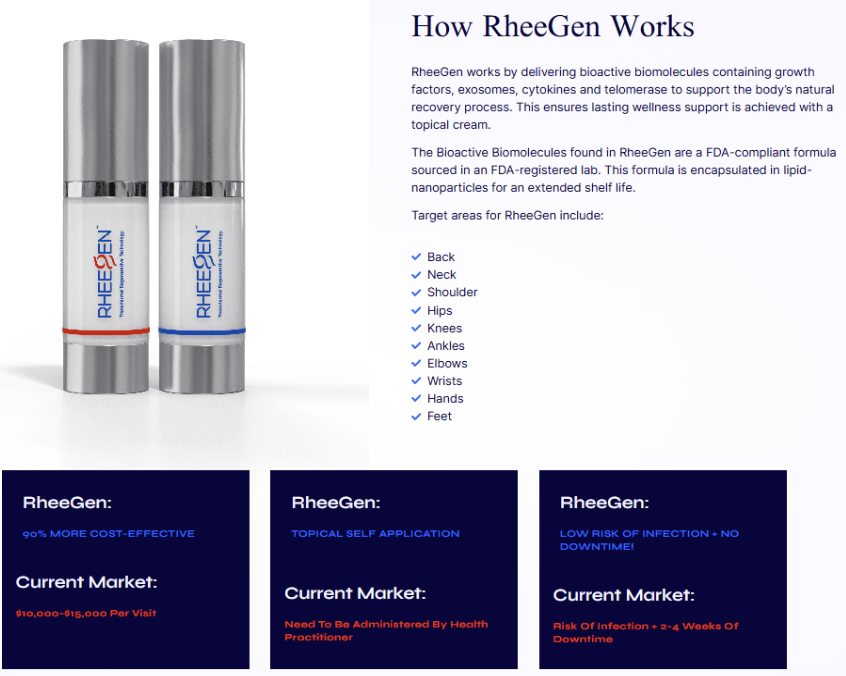Groundbreaking Therapy: How SunPowerLED and RheeGen Can Enhance Regenerative Wellness Support
(These statements have not been evaluated by the FDA. This product is not intended to diagnose, treat, cure, or prevent any disease.)
by Dr. Tommy Rheed, DC
SunPowerLED, a leading photobiomodulation (PBM) device, has revolutionized regenerative medicine by utilizing specific light wavelengths—primarily red (620–700 nm) and near-infrared (NIR, 700–1440 nm)—to stimulate cellular repair and tissue regeneration. This therapy enhances nitric oxide (NO) production, improving circulation and enabling extracellular vesicles (EVs) to penetrate deep into damaged tissues (Avci et al., 2013; Anders et al., 2015; Maghfour et al., 2024; Poyton & Ball, 2011; Weihrauch et al., 2021). By delivering precise wavelengths within the optimal 600–850 nm range, SunPowerLED optimizes cellular stimulation and maximizes regenerative potential (Bagheri et al., 2016; Gholami et al., 2022). This process has been shown to boost ATP production, increase reactive oxygen species (ROS), and activate key cellular pathways involved in tissue repair and stem cell proliferation (Prindeze et al., 2012; Pinto et al., 2021; Trajano et al., 2018).

RheeGen: A Groundbreaking Solution for Regenerative Wellness
RheeGen has also revolutionized regenerative medicine. It is a topical transdermal cream containing extracellular vesicles (EVs) including Bioactive Biomolecules derived from Wharton’s Jelly Mesenchymal Stem Cells (WJMSCs). These EVs are rich in bioactive Biomolecules such as proteins, lipids, exosomes, enzymes, growth factors, cytokines, and genetic material that signal cells to promote deep tissue regeneration and support inflammation reduction (Elliott & He, 2021; Madrigal et al., 2014).
Unlike traditional regenerative treatments that rely on injections or invasive procedures, RheeGen is applied topically, allowing for easy use and effective absorption. This innovative approach enhances support of cellular repair while minimizing discomfort, cost, and risk, making it a game-changer in the field of regenerative medicine (De Freitas & Hamblin, 2016).
In a pilot study of 80 patients with osteoarthritis (OA) and low back pain, treatment with RheeGen resulted in a 51% reduction in Visual Analog Scale (VAS) pain scores within four weeks, demonstrating its effectiveness in managing pain and improving joint function.

How SunPowerLED and RheeGen Work Together
SunPowerLED and RheeGen form a powerful duo in advancing tissue regeneration support. When used in combination, their synergistic effect is estimated to enhance tissue repair support by up to 100%. SunPowerLED stimulates cellular activity and increases nitric oxide (NO) production, which improves circulation and cellular responsiveness. Simultaneously, RheeGen delivers potent extracellular vesicles (EVs) and Bioactive Biomolecules derived from Wharton’s Jelly Mesenchymal Stem Cells (WJMSCs) directly to issue areas. This all-natural formula of EVs and Bioactive Biomolecules carry vital signals that promote repair, reduce inflammation, and accelerate healing (Elliott & He, 2021).
Together, these therapies maximize the body’s natural regenerative potential. SunPowerLED acts as a transdermal delivery enhancer by increasing blood flow and creating micro-pathways in the skin, allowing RheeGen’s formula to penetrate deeper into affected areas. Once delivered, these bioactive vesicles release regenerative molecules that support tissue recovery and modulate inflammation (De Freitas & Hamblin, 2016). The combined application of SunPowerLED and RheeGen represents a breakthrough in non-invasive regenerative medicine, delivering results that exceed those of either therapy used alone.
Recommended Protocol
For optimal results, the recommended protocol involves two daily sessions for 30 days straight:
- Morning Routine:
Apply SunPowerLED for 10 minutes to the targeted area using dual wavelengths of 660 nm and 810 nm. Immediately afterward, apply Alpha RheeGen cream to the affected area and gently massage it into the skin. Then, follow with an additional 10 minutes of SunPowerLED therapy at the same wavelengths (660 nm and 810 nm). - Evening Routine (Before Sleep):
Begin with 10 minutes of SunPowerLED therapy at 660 nm and 810 nm on the targeted area. Then, apply Omega RheeGen to the damaged tissue, massaging it into the skin thoroughly. Conclude with another 10-minute session of SunPowerLED at the same wavelengths.This twice-daily protocol, maintained for 30 days straight, enhances absorption, promotes cellular repair throughout the 30-day period.
Conclusion
SunPowerLED and RheeGen form a powerful duo for supporting cellular regeneration. SunPowerLED stimulates cellular activity, increases nitric oxide production, and enhances the effectiveness of bioactive biomolecules and EVs, while RheeGen delivers the critical regenerative building blocks (Madrigal et al., 2014). The combination of RheeGen’s targeted healing with SunPowerLED’s ability to optimize transdermal absorption creates a synergistic effect, maximizing the delivery of bioactive biomolecules and EVs to target tissues (Gholami et al., 2022; Wang et al., 2017).
References
- Anders, J. J., Lanzafame, R. J., & Arany, P. R. (2015). Low-level light/laser therapy versus photobiomodulation therapy. Photomedicine and Laser Surgery, 33(4), 183.
- Avci, P., Gupta, A., Sadasivam, M., Vecchio, D., Pam, Z., Pam, N., & Hamblin, M. R. (2013). Low-level laser (light) therapy (LLLT) in skin: stimulating, healing, restoring. Seminars in Cutaneous Medicine and Surgery.
- Bagheri, S., et al. (2016). High-power laser irradiation enhances EV biogenesis. Journal of Photochemistry and Photobiology B: Biology.
- De Freitas, L. F., & Hamblin, M. R. (2016). Proposed mechanisms of photobiomodulation or low-level light therapy. IEEE Journal of Selected Topics in Quantum Electronics, 22(3), 348-364.
- Elliott, R. O., & He, M. (2021). Unlocking the power of exosomes for crossing biological barriers in drug delivery. Pharmaceutics, 13(1), 122.
- Gholami, L., et al. (2022). Effect of photobiomodulation on structure and function of extracellular vesicle secreted from mesenchymal stem cells. Photochemistry and Photobiology, 98(6), 1447-1458.
- Madrigal, M., Rao, K. S., & Riordan, N. H. (2014). A review of therapeutic effects of mesenchymal stem cell secretions. Journal of Translational Medicine, 12, 1-14.
- Pinto, H., et al. (2021). The effect of photobiomodulation on human mesenchymal cells: a literature review. Aesthetic Plastic Surgery, 45, 1826-1842.
- Poyton, R. O., & Ball, K. A. (2011). Therapeutic photobiomodulation: nitric oxide and a novel function of mitochondrial cytochrome c oxidase. Discovery Medicine, 11(57), 154-159.
- Prindeze, N. J., Moffatt, L. T., & Shupp, J. W. (2012). Mechanisms of action for light therapy: a review of molecular interactions. Experimental Biology and Medicine, 237(11), 1241-1248.
- Trajano, L. A. d. S. N., et al. (2018). Low power lasers on genomic stability. Journal of Photochemistry and Photobiology B: Biology, 180, 186-197.
- Wang, Y., et al. (2017). Photobiomodulation of human adipose-derived stem cells using 810 nm and 980 nm lasers. Biochimica et Biophysica Acta – General Subjects, 1861(2), 441-449.
- Weihrauch, D., et al. (2021). Red light stimulates vasodilation through extracellular vesicle traffickin
